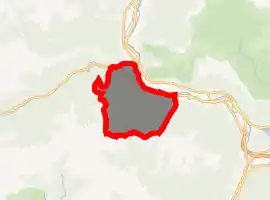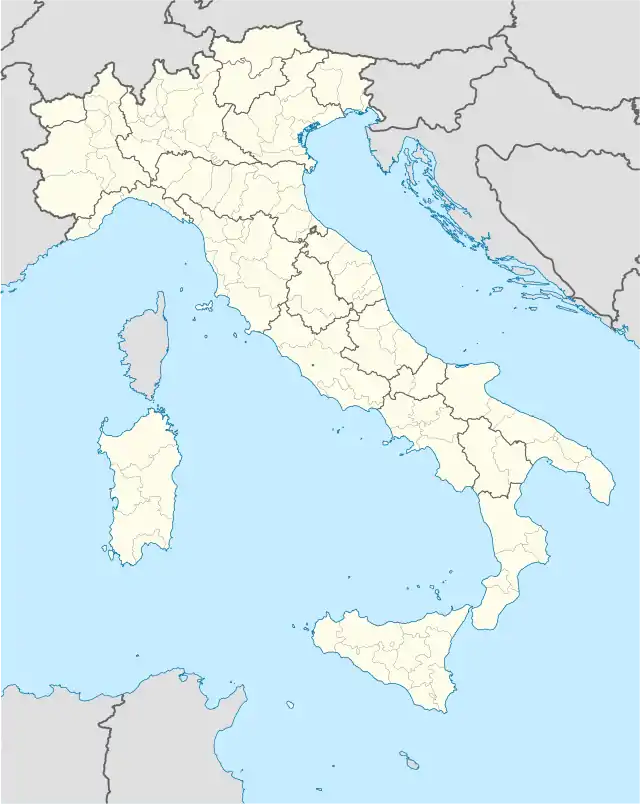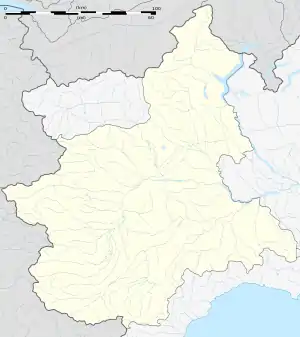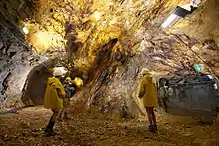Pieve Vergonte
Pieve Vergonte is a comune (municipality) in the Province of Verbano-Cusio-Ossola in the Piedmont region of Italy. It is about 20 kilometres (12 mi) northwest of Verbania and 110 kilometres (68 mi) northeast of Turin.
Pieve Vergonte | |
|---|---|
| Pieve Vergonte | |
 Coat of arms | |
Location of Pieve Vergonte 
| |
 Pieve Vergonte Location of Pieve Vergonte in Italy  Pieve Vergonte Pieve Vergonte (Piedmont) | |
| Coordinates: 46.0045402°N 8.268456°E | |
| Country | Italy |
| Region | Piedmont |
| Province | Verbano-Cusio-Ossola (VB) |
| Frazioni | Fomarco, Rumianca, Megolo Cima, Megolo Mezzo, Megolo Fondo[1] |
| Government | |
| • Mayor | Maria Grazia Medali[2] |
| Area | |
| • Total | 41.67 km2 (16.09 sq mi) |
| Elevation | 232 m (761 ft) |
| Population (31 December 2015)[1] | |
| • Total | 2,593 |
| • Density | 62/km2 (160/sq mi) |
| Demonym(s) | Pievesi[1] |
| Time zone | UTC+1 (CET) |
| • Summer (DST) | UTC+2 (CEST) |
| Postal code | 28886 |
| Dialing code | 0324 |
| Patron saint | St. Vincent and St. Atanasius[1] |
| Saint day | 22 January[1] |
| Website | Official website |
Geography
Pieve Vergonte lies in the valley of Ossola where the Anza river flows into the Toce. It is bordered, west to east, by the municipalities of Piedimulera, Vogogna, Premosello-Chiovenda, and Anzola d'Ossola.[3] It is about 20 kilometres (12 mi) northwest of Verbania and 110 kilometres (68 mi) northeast of Turin.
The town is served by State Highway 33 from Simplon.[4] 20th century to today
History
18th century
Following the Spanish Succession War (1701-1714) ended with the peace treaty of Utrecht (1713) and specifically the peace treaty of Rastatt (1714), the King of Spain Philip V was forced to cede the Kingdom of Naples, the Kingdom of Sardinia, the State of the Presidia and much of the Duchy of Milan to the emperor Charles VI. The Ossola and with it Pieve Vergonte followed the political destiny of the Duchy of Milan passing under Austrian administration.
The Duchy of Savoy led by the Duke Vittorio Amedeo II acquired the kingdom of Sicily exchanged in 1720 for the Kingdom of Sardinia and part of the Duchy of Milan. Vittorio Amedeo II concluded the political goal of transforming the noble title from Duke to King.
Following the Austrian Succession war (1740-1748) and the related Worms treaty of 1743 and the Aachen treaty of 1748 which ended the conflict, the Kingdom of Sardinia acquired Ossola, including Pieve Vergonte . The King of England, the Queen of Bohemia and Hungary, Empress of the Holy Roman Empire and the King of Sardinia signed a military alliance on the English initiative with the transfer of territories under Austrian control to the Kingdom of Sardinia that moved the border to Lake Maggiore and along the Ticino river until it enters the river Po. After 29 years of Austrian rule, Pieve Vergonte passed under the administration of the House of Savoy, whose destiny it will follow until its fall.
In the year 1775 King Vittorio Amedeo III, approved, with Patente June 6, 1775, the new Regulation for municipal administrations. The community of Vogogna was considered too extensive for which the ancient Municipality of Vogogna originally consisting of ten lands was divided into six distinct and separate Municipalities: Vogogna con Prata; Pallanzeno; Piedimulera; Cimamulera; Fomarco; Rumianca with the hamlets of Megolo, Loro and Pieve Vergonte.
19th century
In 1800 Napoleon descended into Italy and with a proclamation of October 15, he reorganized the upper and lower Novara area in the Agogna department. With the law of 2 November 1800, Ossola depended administratively on the Compartment of Agogna, subdivided into 17 districts. Vogogna, declared Capital of the XIV District, still preserved its ancient Jurisdiction of the Lower Ossola and the Anzasca Valley with 26 Municipalities including Fomarco.
The decree of 8 June 1805 on the Public Administration and the territorial compartment of the Kingdom of Italy, whose capital was Milan, divided the Kingdom into Departments, Districts, Cantons and Municipalities. Pieve Vergonte, part of the Municipality of Rumianca, together with the municipalities of Pallanzeno, Piedimulera, Cimamulera, Anzino, Valle Anzasca, Fomarco, Anzola, Migiandone, Ornavasso, Mergozzo, Cuzzago and Premosello, was part of the Canton of Vogogna which was its capital.
In the year 1847 Pieve Vergonte was still a fraction of Rumianca to which also the hamlets of Megolo and Loro belonged.
In the year 1847, it is still written about Rumianca that:
... the little plain susceptible of cultivation is devastated by the torrents Marmazza, Anza and Inferno, which descend precipitously/rapidly from the mountains above, and flow into the Toce river
in their high waters they bring much damage to the countryside, they threaten the ruin of the countries through which they pass and it is able to greatly aggravate this commune by holding back the impetus by means of suitable banks.
A chain of mountains lies behind the places of which the Municipality is composed: on the backs of the same many many chestnut woods and in many sites there are also many tall trees, there are no pastures to feed numerous cattle. The territory produces rye, meliga, millet, chestnuts and grapes in fair quantities, the products of bovine animals and lanute is very considerable. [without source]
In the year 1861, with the birth of the Kingdom of Italy, Ossola and with it Pieve Vergonte passed under the administration of the Province of Novara.
20th century and today
_-_BEIC_6342594.jpg.webp)
In the year 1928 the Municipality of Fomarco and the Municipality of Rumianca were definitively abolished and they were reunited in a single Municipality with the name "Pieve Vergonte", having a population of 1.916 Inhabitants. The suppressed Municipalities are abandoned.
During the Second World War the mountain territories around Pieve Vergonte, like those of the whole Val d'Ossola, witnessed an important activity partisan, in particular the formation of the commander Filippo Beltrami, one of the first in the area between Cusio and Ossola, which at the end of January 1943 had placed its temporary base in Pievese territory, in Cortavolo, just above the hamlet of Megolo Mezzo. On February 13 1944 this area was the scene of the battle of Megolo, between the partisan group of Beltrami and the Nazi-fascist troops of the German army and of the Italian Social Republic coming from Domodossola and Novara, under the command of Captain Ernst Simon.
During the day, between the clash and the shooting, the commander Filippo Beltrami, the political commissar Gianni Citterio, the deputy commander Antonio Di Dio and nine other partisans fell: Carlo Antibo, Giovanni Bressani Bassano, Aldo Carletti, Angelo Clavena, Bartolomeo Creola, Emilio (or Cornelio) Gorla, Paolo Marino, Gaspare Pajetta and Elio Toninelli.[5] The rest of the group managed to retreat to the mountains.
After the end of the war on April 25, 1945, on May 9, 1945 the shooting of 11 was registered in Pieve Vergonte, Val d'Ossola militias of the Italian Social Republic by partisan forces Canapa Angelo Francesco (Carrara 18.10.1925), Conti Angelo (Rome 11.1.1893), Di Giovanni Carlo (Rome 25.9. 1894), France Michele (Velletri 3.9.1900), Micale Salvatore (Taviano 2.12.1919), Search Dino, De Deo Giuseppe (Civitavecchia 16.12.1910), Perlini Vittorio (Frosinone 1.1.1902), Princigalli Giovanni, Tesoro Alfredo (Terlizzi 14.10.1927) and his brother Tesoro Giuseppe (Terlizzi 24.8.1925). A civilian is also shot, Serafini Amelia (Macerata 29.6.1901).[6]
These soldiers belonged to the Black Brigade Ministerial,[7] a unit taken to the Val d'Ossola after the re-occupation of the Partisan Republic territory in October 1944. The Black Ministerial Brigade was born following the imminent fall of Rome in 1944, by Benito Mussolini and Alessandro Pavolini,[8] Secretary of the Republican Fascist Party, who militarized the Republican Fascist Party, transforming the provincial formations into the Black Brigades.[9] On 27 August 1944, the Chief of Staff of the Black Brigades, Giovanni Battista Riggio, circulated a circular addressed to state and ministerial employees in which he hoped for their voluntary registration in the brigades.[10] Pavolini, in turn, announces on September 17, 1944, the establishment of special ministerial departments, thus creating the Black Autonomous Ministerial Brigade, based in Brescia (704 Post Office) and which obtains the greatest success among the officials of the Ministries of Finance and of the Popular Culture[10]
After the end of the war on April 25, 1945, the partisans shot three civilians in Pieve Vergonte: Mr. Casella and Signora Calvi, inhabitants of Pieve Vergonte, and Mr. Bettineschi living in Fomarco. Mr Casella and Mrs. Calvi were temporarily buried at Alpe Piana, in Val Toppa, above the village of Pieve Vergonte. Mr. Bettineschi was temporarily buried in a mine gallery at Alpe Fontano, in Val Toppa, above the village of Pieve Vergonte.[11]
At the beginning of April 1945 a German chemist (anti-Nazi. was appropriated by the Garibaldini of Megolo. He apologized for the continuous delay in the production of a powerful aggressive chemical) who was in charge of monitoring the progress of some chemical plants including Rumianca. On 10 April 1945 a commando was sent to Megolo with the task of escorting him to the Command for an exchange. He tried to escape and a partisan killed him. He was buried in great secrecy in a field, then, following the grievances of the owner, he was transferred, still in great secrecy, to the Cemetery. The partisan commander, Baron Alessandro Cavalchini (Sandro), of monarchical convictions, warned of the family at the end of the war. In 1978 in Anzola the restoration of the Chapel of the Holy Cross was inaugurated, a donated restoration, together with a Crucifix and a tombstone with the donor's words, by Alessandro Cavalchini.[12]
Main sights



- The Church of Pieve Vergonte
- The Workers' Village, designed by architect Paolo Vietti-Violi from Vogogna, is, with the one of Villadossola, among the model villages for northern workers built during the years of Benito Mussolini's government (1922–1943).[13]
- The Chemical Factory, with offices designed by Vietti-Violi
- The cinema designed by Vietti-Violi[14]
- The mill for grinding gold ore, of which only the tub remains, at the Park of the Fallen of the Great War
- Borgaccio Wall, near the river Toce, which demarcates Pieve Vergonte from the nearby village of Vogogna. It is the remains of a wall of the castle of Pietra Santa, which was destroyed on 9 February 1348, and it is commonly called the Borgaccio.
Economy
Industry
The industrial chemical plant of Pieve Vergonte was founded in 1915 on the initiative of the Italian Society of Explosive Products (PETS) based in Milan, with capital of 2,500,000 lire. The first production for military purposes was the production of iodine monochloride of chlorobenzene and phosgene used during the First World War and later in the African campaign.
During World War II, Clorosoda, sulfuric acid, and fertilizers were produced. After the war, shutting down the production of sulphuric acid, Rumianca SpA, and then the SIR Group, developed new product lines for the production of DDT and chloroaromatics. These products were used by the United States of America during the Vietnam War.
In 1981, the facilities of this company were transferred to the ENI Group and the ANIC Company. The ANIC, then EniChem, DDT plants ran until June 1996, and remaining in production until their sale on 1 July 1997 to Tessenderlo, Italy. The clorosoda, chlorine and aromatic synthetic HCL are in production for the Tessenderlo Group.
In May 2013, Tessenderlo Group sold Tessenderlo Partecipazioni SpA, and its subsidiary Tessenderlo Italy Srl, to International Chemical Investors Group (ICIG).[15] The transaction includes the plant in Pieve Vergonte (VB), where there now are an active electrolysis plant, one for chloro-aromatics, and two hydroelectric plants that provide energy. Tessenderlo Italy employs a total of 113 people. Achim Riemann, Managing Director of ICIG, said: "The integration upstream of Tessenderlo Italy, with direct supply of energy through its hydroelectric plants, is vital for the competitiveness of the plant of Pieve Vergonte and so we want to maintain this integration and have both hydroelectric concessions renewed for the long term." The company trades under the name of hydrochemitalia.[16]
Energy production
The village of Pieve Vergonte produces electricity from hydroelectric power. The largest producer is the Edison Company with plants in Val Anzasca and Pieve Vergonte, both fed by the waters of the river Anza with a total average production of 95 GWh. The second-largest producer is Tessenderlo's Battiggio plant, ex-Rumianca of Ceppo Morelli in Val Anzasca, on the Toce river at Megolo, which has a total average production of 90 GWh.
Natural resources and minerals
Along the creek Marmazza, above the village of Pieve Vergonte, in the Toppa Valley, mining is of great value. There are many pyrite minerals scattered throughout the Ossola valley, which can not be easily mined, and which are entirely neglected. Gold-bearing pyrites were first detected in the quarries of the Maffiola brothers in the valley.
The extraction of gold from the mines of the Toppa Valley was done with mercury, a process first developed by the Spaniard Pedro Fernandez de Velasco in the Americas and thence introduced to Europe by Baron De Born, where an amalgamation was obtained with of fire, and which was used in all the gold mines in Ossola.[17]
The gold production of the Val Toppa mining company, which was listed on the London Stock Exchange in 1863, valued in British pounds/shillings/pence:[18]
- 1864 – Production 509 oz (14.43 kg) & .275 – £1798/18/9 (566,560 Euros in Jan 2017)
- 1865 – Production 574 oz (16.28 kg) & .575 – £2032/14/5 (638,911 Euros in Jan 2017)
- 1866 – Production 1400 oz (39.69 kg) & .925 – £4957/15/8 (1,558,320 Euros in Jan 2017)
with an average production of 1 ounce "oz" and 5 pennyweight "dwt" of gold per tonne of ore mined.
References
- "Il Comune in Breve" [The Municipality in Brief]. Comune di Pieve Vergonte (in Italian). Retrieved 14 February 2018.
- "Sindaco" [Mayor]. Comune di Pieve Vergonte (in Italian). Retrieved 14 February 2018.
- "Come Raggiungerci" [How to reach us]. Comune di Pieve Vergonte (in Italian). Retrieved 23 February 2018.
- "Home". Comune di Pieve Vergonte (in Italian). Retrieved 23 February 2018.
- Paolo Bologna (2007). The battle of Megolo. Municipality of Pieve Vergonte. pp. 85–87.
- http://fondazionersi.org/mediawiki/images/4/4e/Acta77.pdf
- http://www.rncrrsinov.altervista.org/repartiopavanti.htm
- cucite, Pubblicato da bocche. "ALESSANDRO PAVOLINI".
- Alessandro Pavolini: life, business and death of the man who invented fascist propaganda Front Cover Giovanni Teodori Castelvecchi, 2011 - Biography & Autobiography - 252 pages
- l Ministry of Foreign Affairs and International Relations of the Italian Social Republic (1943-1945) Marino Viganò Editoriale Jaca Book, 1991 - Political Science - 677 pages
- The blood of the defeated Front Cover Giampaolo Pansa Sperling & Kupfer, 7 Oct 2010 - History - 392 pages
- Giuliano Vassalli (1997). Ne Valeva La Pena: From the Republic of the Ossola to the Italian Constitution. M & B Publishing. p. 68. ISBN 8886083394.
- (Simon Martin, 2004, p.81)
- (Canella, Giuntini, 2009, p.280)
- "Who We Are". International Chemical Investors Group. Retrieved 19 February 2018.
- "Benvenuti nel sito internet di HydroChem Italia - Pieve Vergonte" [Welcome to the Website of HydroChem Italia - Pieve Vergonte]. HydroChem Italia (in Italian). Retrieved 19 February 2018.
- Rosina 1819.
- "XE Currency Converter". XE.com. Retrieved 19 February 2018.
Sources
- De Bartolomeis, G. Luigi (1843). Notizie topografiche e statistiche sugli stati sardi: dedicate A.S.S.R.M Carlo Alberto [Topographical Data and Statistics on Sardinian States: dedicated to His Majesty Charles Albert] (in Italian). Turin: Chirio e Mina. Retrieved 28 February 2018.
- Casalis, Goffredo (1847). Dizionario geografico, storico, statistico, commerciale degli stati di S.M. il re di Sardegna [Geographical, historical, statistical, commercial dictionary of the states of H.M. the king of Sardinia] (in Italian). 16. Turin: Presso G. Maspero Librajo. p. 652. Retrieved 21 February 2018.
- Diacono, Paolo (1990). Pin, Italo (ed.). Storia dei Longobardi [History of the Lombards]. Biblioteca di storia (in Italian). Pordenone: Studio Tesi. ISBN 978-887692231-2. Retrieved 7 April 2018.
- Jenkinson, Charles (1785). A collection of all the treaties of peace, alliance, and commerce between Great Britain and other Powers, from the treaty signed at Munster in 1648 to the treaties signed at Paris in 1783. II – from 1713 to 1748. London, opposite Burlington House, Piccadilly: J. Debrett. Retrieved 19 February 2018.
- Labus, Giovanni (1842). Antica romana via del Sempione: nuovamente osservata e illustrata; con monumenti contemporanei [The Ancient Roman Road from Simplon: newly observed and illustrated; with contemporary monuments] (in Italian). Milan: I. R. Istituto lombardo. Retrieved 19 February 2018.
- Martin, Simon (2004). Football and Fascism: The National Game Under Mussolini. New York, USA: Berg Publishers. ISBN 978-185973705-7. Retrieved 24 April 2018.
- Robolini, Giuseppe (1826). Notizie appartenenti alla storia della sua patria: raccolte ed illustrate da Giuseppe Robolini, gentiluomo pavese [News belonging to the history of his homeland: collected and illustrated by Giuseppe Robolini, a gentleman from Pavia] (in Italian). II. Pavia: Fusi e Comp. Retrieved 24 February 2018.
- Rosina, Gaetano (1819). Osservazioni e richerche minearologiche-chimiche sopra alcune valli dell'ossola del chimico Gaetano Rosina: coll'aggiunta di un metodo economico per estrarre l'oro da una miniera di quei dintorni riputata finora incoltivabile [Observations and mineralological-chemical researches in some valleys of the Ossola by the chemist Gaetano Rosina: with an economic method for extracting gold from a mine whose surroundings have been rebuilt and is now unworkable] (in Italian). Milan: Giovanni Pirotta. Retrieved 19 February 2018.
- Soldani, Massimiliano (1999). L'ultimo poeta armato: Alessandro Pavolini segretario del Partito fascista repubblicano [The last armed poet: Alessandro Pavolini, secretary of the Republican Fascist Party]. Sinergie (in Italian). Milan: Barbarossa. OCLC 43082470. Retrieved 7 April 2018.
- Viganò, Marino (1991). Il Ministero degli Affari Esteri e le Relazioni Internazionali della Repubblica Sociale Italiana: 1943–1945 [The Ministry of Foreign Affairs and International Relations of the Italian Social Republic: 1943-1945] (in Italian). Milan: Jaca Book. ISBN 978-881695081-8. Retrieved 24 March 2018.
- De Vit, Vincenzo (1859). Memorie Storiche di Borgomanero e del suo mandamento compilate dal Sacerdote Vincenzo De Vit [Memories of Borgomanero and his mandate: compiled by Father Vincenzo De Vit] (in Italian). Milan: Ditta Boniardi Pogliani di Ermenegildo Besozzi. Retrieved 24 April 2018.
- Memorie del Reale istituto lombardo di scienze, lettere ed arti, Volume 1,- Milano – Tipografia Bernardoni – 1843
| Wikimedia Commons has media related to Pieve Vergonte. |